Whale Season Big Island: Your Ultimate Guide
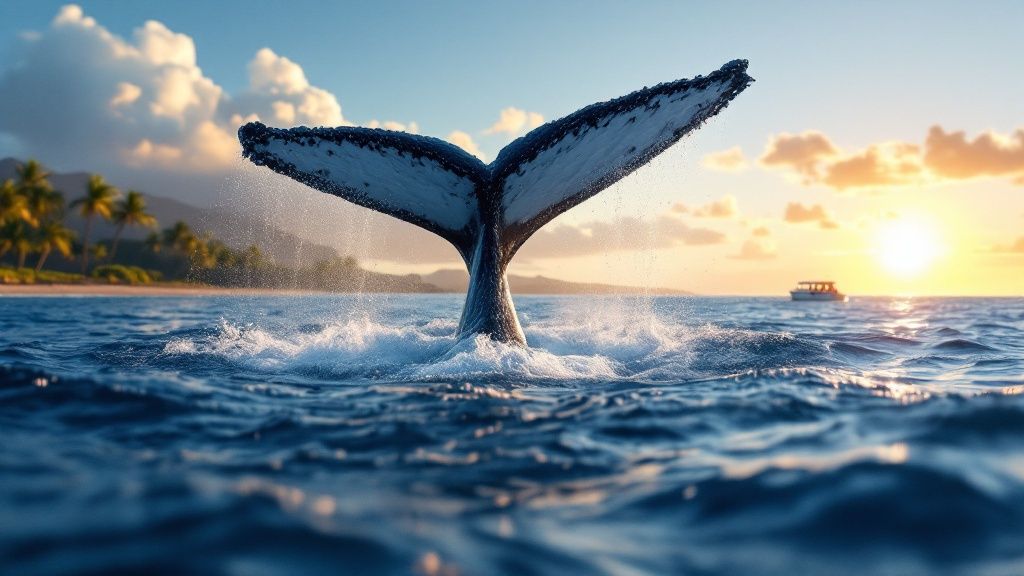
Picture this: a 40-ton humpback whale explodes from the ocean, twisting in mid-air before crashing back down in a colossal splash. This isn't a scene from a nature documentary—it's the magic of whale season right here on the Big Island, and you can see it for yourself.
The absolute best time of year to see whales is typically mid December through end of March. This guide is your ticket to witnessing one of the planet's most breathtaking migrations.
Welcome to Hawaii's Most Awe-Inspiring Event
We’ll get into why the warm, sheltered waters off the Kohala Coast become the go-to spot for thousands of these gentle giants every single year. You'll also see why folks consistently rate Kona Snorkel Trips as the top rated & most reviewed snorkel company in Hawaii.
Let's dive into the peak viewing times, the best spots to watch from shore, and how to pick the perfect Big Island whale watching tour for an adventure that will stick with you forever.
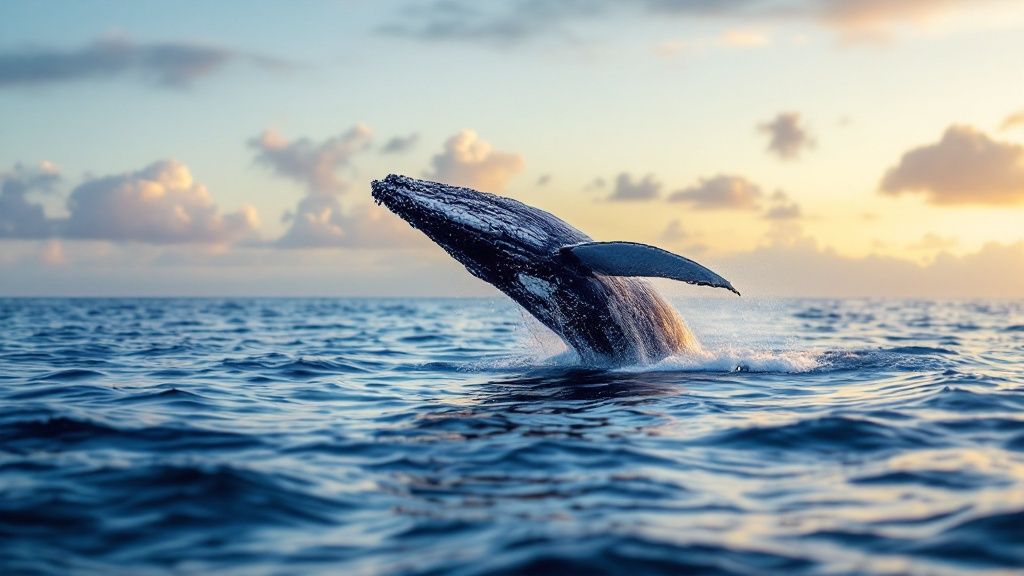
This annual migration completely transforms the waters around the island. What was once quiet ocean becomes a bustling nursery, alive with activity.
You might hear the powerful thwack of a tail slap echoing for miles or witness the unforgettable sight of a full breach. Each moment is a raw, powerful reminder of the ocean's majesty. Planning your trip during these key months gives you the best possible shot at seeing these behaviors up close.
For a truly immersive experience, nothing beats one of the guided Big Island whale watching tours. Getting out on the water with experts who live and breathe this stuff is a game-changer. They know the whales' patterns and can get you safely closer to the action. It's an unforgettable way to connect with these magnificent animals.
Understanding the Humpback Whale Migration
Every winter, the waters around the Big Island come alive. It's not just a casual visit; it's the final stop on an epic, instinct-driven journey for thousands of humpback whales. These incredible animals travel over 3,000 miles from their chilly feeding grounds in Alaska all the way to the warm, protected seas surrounding Hawaii. This migration is one of the longest of any mammal on the planet.
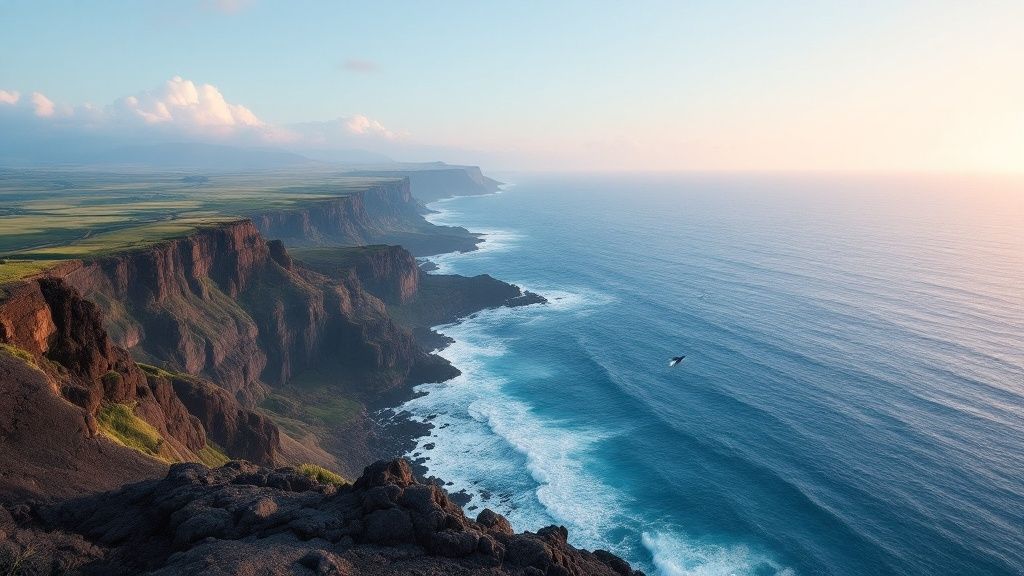
But why on earth do they make such a long and demanding trip? It all comes down to family. The Big Island's coastal waters essentially become a massive, natural nursery. The warm, shallow depths provide a safe haven for female whales to give birth and nurse their newborn calves, far from the predators lurking in colder seas.
This makes the whale season Big Island experience so much more than just spotting whales. You're witnessing a critical chapter in their lives unfold right before your eyes.
The Rhythm of the Season
While the first few whales start showing up around November, the real party gets started as winter sets in. The population swells dramatically, hitting its absolute peak in January and February. During these months, the waters are just bustling with activity—whales engaging in powerful courtship rituals, mothers teaching their young, and plenty of spectacular behaviors on display.
Timing and location are everything when it comes to having a great sighting. The Kohala coast is the prime spot for humpback activity, especially during those peak months. Here’s a pro tip: early mornings are often your best bet. We've noticed around 50% more whales at 8:00 a.m. compared to midday, partly because the ocean surface is usually calmer, making them easier to spot. Come March, the sighting numbers typically get cut in half, so that mid-winter window is truly golden.
To help you plan, here's a quick look at what you can expect each month during the season.
Big Island Whale Season Monthly Breakdown
| Month | Whale Activity Level | Typical Behaviors Observed |
|---|---|---|
| November | Low to Moderate | First arrivals, often spotted further offshore. Mostly individual adults. |
| December | Moderate to High | Population increasing, more frequent sightings of spouts and tail slaps. |
| January | Peak | Highest concentration of whales. Frequent breaches, courtship groups, and calf sightings. |
| February | Peak | Similar to January; very active with lots of surface behaviors. Prime viewing time. |
| March | High to Moderate | Whales begin their journey back to Alaska. Lots of mothers with calves. |
| April | Low | Last of the whales departing, sightings become much less frequent. |
As you can see, planning your trip around January or February gives you the best odds of seeing the most dramatic action.
The ocean transforms into a dynamic stage where every spout, breach, and tail slap tells a story. It’s a powerful display of nature's rhythm, playing out right before your eyes.
By understanding this annual cycle, you can plan your adventure to be there when the action is at its best. For an even deeper dive into this topic, you can explore more details in our complete guide to Hawaii's whale season. Knowing the story behind the migration adds a whole new layer of appreciation for every majestic creature you see on a whale watching Hawaii Big Island tour.
Finding the Best Shoreline Viewing Spots
Think you need to be on a boat to get the full, breathtaking experience of whale season Big Island? Think again. Some of the most magical whale encounters happen with your feet planted firmly on solid ground, right along the island's stunning coastline.
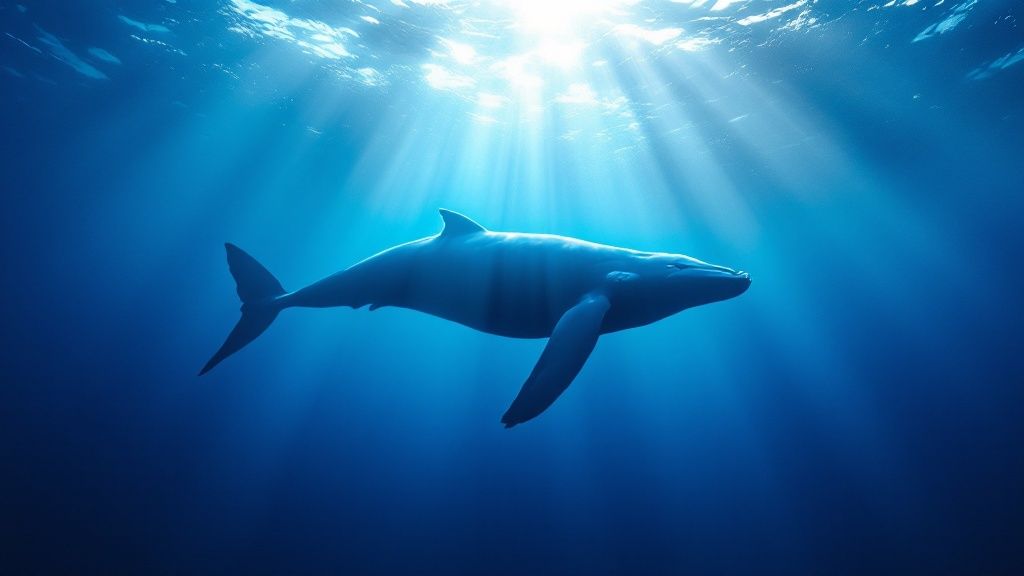
The Kohala Coast, often called the "Gold Coast," is legendary for its sunny weather and calm, clear waters. These perfect conditions make it a prime highway for migrating humpbacks, and they often travel surprisingly close to the shore here. It's not uncommon to see a breach while you're just driving down the road!
For a spot that combines incredible views with deep cultural meaning, you can't beat the Puʻukoholā Heiau National Historic Site. The grounds are elevated, giving you a sweeping panoramic vista of the ocean that’s absolutely perfect for spotting pods. It's a powerful experience to stand on such historic land while watching these giants play offshore.
Maximizing Your Shoreline Sighting Success
Of course, finding a great spot is only half the adventure. Knowing how to watch makes all the difference between a frustrating afternoon and an unforgettable one. A little strategy and the right gear are all it takes to make your shore-based whale watching Big Island trip a massive success.
Here are a few essential tips to help you spot these gentle giants from land:
- Bring Binoculars: Seriously, this is non-negotiable. A decent pair of binoculars turns a distant splash into a front-row seat for a spectacular breach or tail slap. It's the single best tool for the job.
- Time Your Visit: Your best bet is almost always the early morning. The ocean is typically calmer then, creating a glassy surface that makes it way easier to spot a spout or the dark shadow of a whale just beneath the water. The low-angle sun also cuts down on that blinding glare.
- Know What to Look For: This is a game of patience. Scan the horizon slowly and methodically. You’re looking for the tell-tale signs: a puff of mist (the "spout" from their blowhole), a massive splash from a tail slap, or the grand prize—a full breach, where the whale launches its entire body out of the water.
Packing a little patience and a good pair of binoculars can turn a simple coastal drive into an epic whale watching expedition. The key is to find a comfortable spot, settle in, and just let your eyes slowly roam across the horizon.
With these simple tips, your land-based whale watching Hawaii Big Island adventure can be just as rewarding as any boat tour.
Choosing Your Ideal Big Island Whale Watching Tour
Sure, spotting a whale from the shore is a serious thrill, but getting out on the water is a whole different world. It’s an immersive experience that you just can’t replicate from land. A good guided tour not only gets you closer to the action but also gives you access to the crew’s expert knowledge—these guys know these waters and the whales' habits inside and out.
With so many options for Big Island whale watching tours, picking the right one can feel a little overwhelming. But trust me, choosing the right operator is the single most important decision for having a memorable and respectful encounter with these amazing animals.
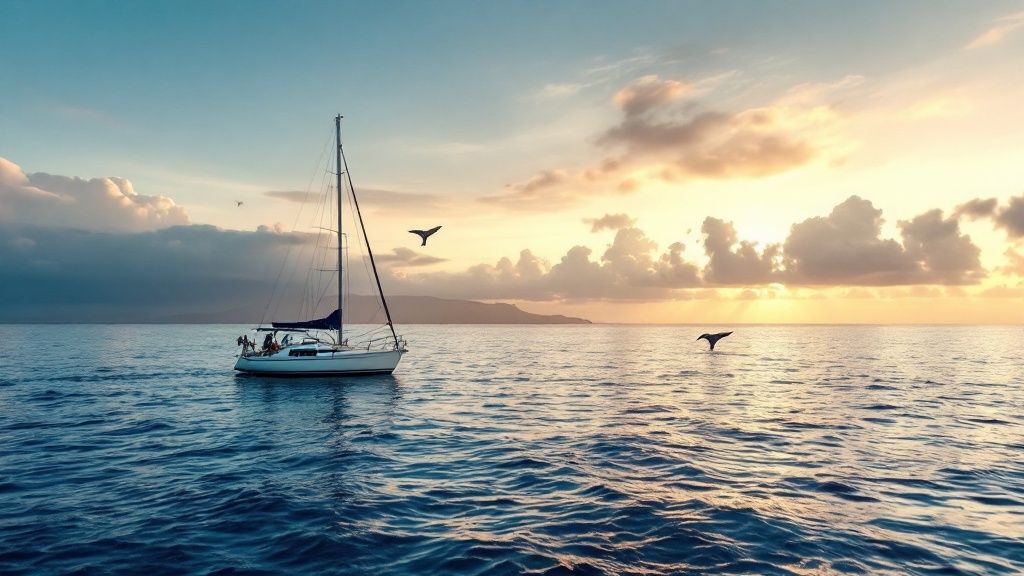
This is where a company like Kona Snorkel Trips really shines. They focus on small-group excursions, which completely changes the vibe of the trip. It feels more like a personal adventure, where you can actually chat with the guides and ask questions without shouting over a crowd. Their trips are specifically designed to make the most of your time on the water during the precious whale season Big Island months. For a deeper dive into what separates a good tour from a great one, check out our guide on the best whale watching tours in Kona, Hawaii.
Dedicated Whale Watching Excursions
If your number one goal is to witness the pure majesty of a humpback whale, then a dedicated tour is exactly what you need. Kona Snorkel Trips' whale watching tour is 100% focused on finding and observing these gentle giants in their natural winter playground.
The crew uses their years of experience to track down active pods, positioning the boat for incredible views while strictly following all wildlife protection laws. This single-minded approach seriously boosts your chances of seeing spectacular behaviors like breaches and tail slaps, making it the perfect choice for any whale watching Kona Big Island adventure.
The Ultimate Ocean Adventure Combo
Want to pack two of the Big Island’s most iconic marine encounters into a single, epic day? The Kona Snorkel Trips Manta & Whale watching tour is an absolutely exceptional option. This one-of-a-kind trip combines the thrill of daytime whale watching Hawaii Big Island with the magical, otherworldly experience of snorkeling with manta rays after sunset.
Choosing a tour operator that puts conservation first is crucial. Responsible companies protect these magnificent animals by educating their guests and following every federal guideline for safe, respectful viewing.
This combo tour is perfect for anyone looking to maximize their time in Hawaii and create a full day of ocean memories you’ll be talking about for years.
What to Expect on a Kona Whale Watching Trip
Stepping onto a boat for a whale watching tour off the Kona coast is where the real adventure begins. The second you clear the harbor, you can feel the excitement building. The captain and crew have years of experience, and their eyes are already scanning the horizon, spotting signs of whale activity that most of us would completely miss.
Their expertise is what turns a good trip into a great one. They don’t just point out the whales; they know their behavior inside and out, sharing fascinating stories about what each splash and surface means. You'll quickly learn the difference between a powerful tail slap and a curious spy-hop, and if you're lucky, you'll witness the jaw-dropping spectacle of a full breach. During peak season, the action is practically non-stop. In fact, one coordinated count in January recorded 493 humpback sightings off the Big Island in a single day.
It’s More Than Just a Sighting
Seeing the whales is incredible, but hearing them is on another level entirely. One of the most magical moments on many Big Island whale watching tours is when the crew drops a hydrophone into the water. Listening to the hauntingly beautiful songs of the male humpbacks echoing up from the deep is an unforgettable, almost mystical experience.
Hearing a whale's song for the first time is something that stays with you. It's a profound connection to the ocean's mysteries and a sound that's impossible to forget.
This multi-sensory approach—seeing their raw power and hearing their complex songs—paints a complete picture of these majestic animals. It turns a simple boat trip into a deep, lasting appreciation for the marine world. For a complete rundown of what to expect, our full guide to whale watching on the Kona Big Island has all the details you’ll need to prepare.
Of course, planning a trip to see the whales always brings up a few questions. To get you feeling ready and excited for your adventure, here are the answers to some of the things people ask us most often about whale watching.
Are Whale Sightings Guaranteed?
That's the million-dollar question, isn't it? Since humpbacks are wild animals, nothing is ever 100% guaranteed. But I can tell you this: during the peak months of January and February, the tour operators here have an incredibly high success rate. They know where to look.
Many of the best companies, like Kona Snorkel Trips, even offer a guarantee. If for some reason the whales are shy and you don't see any, you can go again for free until you do. It gives you some nice peace of mind and makes sure your whale watching Hawaii Big Island experience is a success.
What Should I Bring on a Tour?
A little preparation goes a long way in making a great day on the water even better. Think sun protection first: reef-safe sunscreen, a good hat, and polarized sunglasses are essential for cutting the glare off the ocean. I’d also toss in a light jacket or windbreaker; it can get surprisingly cool and breezy once you leave the harbor behind.
And definitely, don't forget your camera! A zoom lens will be your best friend for capturing those incredible moments. If you’re someone who gets a bit queasy, it’s always a smart move to take some motion sickness medication beforehand—it’s just one less thing to worry about on your Big Island whale watching trip.
How Close Can We Get to Whales?
This is a big one, and it's all about respecting these amazing creatures. Federal law is very clear: all boats have to stay at least 100 yards away. This is for the safety and well-being of the whales, and every reputable captain sticks to it religiously.
But here’s the magic part—humpbacks are incredibly curious. More often than not, they decide to come check us out. There's nothing quite like it when a 40-ton whale gracefully approaches the boat on its own terms. It’s a truly humbling experience and a highlight of any whale watching Kona Big Island tour.
Can We Actually Hear the Whales Sing?
Oh, absolutely! And it's something you will never, ever forget. One of the coolest parts of many Big Island whale watching tours is when the crew drops a hydrophone (an underwater microphone) into the ocean.
When the water is calm, you can clearly hear the haunting, complex songs of the male humpbacks echoing through the water. That sound can travel for miles, and hearing it live gives you a completely different appreciation for these gentle giants. It adds a whole other dimension to the adventure.
